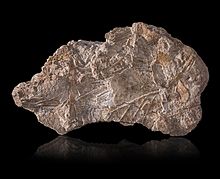
A geyser is a spring characterized by an intermittent discharge of water ejected turbulently and accompanied by steam. As a fairly rare phenomenon, the formation of geysers is due to particular hydrogeological conditions that exist only in a few places on Earth.

A hot spring, hydrothermal spring, or geothermal spring is a spring produced by the emergence of geothermally heated groundwater onto the surface of the Earth. The groundwater is heated either by shallow bodies of magma or by circulation through faults to hot rock deep in the Earth's crust. In either case, the ultimate source of the heat is the radioactive decay of naturally occurring radioactive elements in the Earth's mantle, the layer beneath the crust.

Chert is a hard, fine-grained sedimentary rock composed of microcrystalline or cryptocrystalline quartz, the mineral form of silicon dioxide (SiO2). Chert is characteristically of biological origin, but may also occur inorganically as a chemical precipitate or a diagenetic replacement, as in petrified wood.

The geothermal areas of Yellowstone include several geyser basins in Yellowstone National Park as well as other geothermal features such as hot springs, mud pots, and fumaroles. The number of thermal features in Yellowstone is estimated at 10,000. A study that was completed in 2011 found that a total of 1,283 geysers have erupted in Yellowstone, 465 of which are active during an average year. These are distributed among nine geyser basins, with a few geysers found in smaller thermal areas throughout the Park. The number of geysers in each geyser basin are as follows: Upper Geyser Basin (410), Midway Geyser Basin (59), Lower Geyser Basin (283), Norris Geyser Basin (193), West Thumb Geyser Basin (84), Gibbon Geyser Basin (24), Lone Star Geyser Basin (21), Shoshone Geyser Basin (107), Heart Lake Geyser Basin (69), other areas (33). Although famous large geysers like Old Faithful are part of the total, most of Yellowstone's geysers are small, erupting to only a foot or two. The hydrothermal system that supplies the geysers with hot water sits within an ancient active caldera. Many of the thermal features in Yellowstone build up sinter, geyserite, or travertine deposits around and within them.
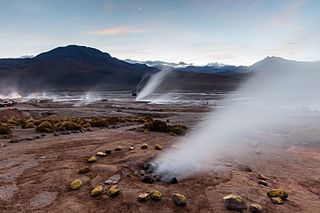
El Tatio is a geothermal field with many geysers located in the Andes Mountains of northern Chile at 4,320 metres (14,170 ft) above mean sea level. It is the third-largest geyser field in the world and the largest in the Southern Hemisphere. Various meanings have been proposed for the name "El Tatio", including "oven" or "grandfather". The geothermal field has many geysers, hot springs, and associated sinter deposits. These hot springs eventually form the Rio Salado, a major tributary of the Rio Loa, and are a major source of arsenic pollution in the river. The vents are sites of populations of extremophile microorganisms such as hyperthermophiles, and El Tatio has been studied as an analogue for the early Earth and possible past life on Mars.
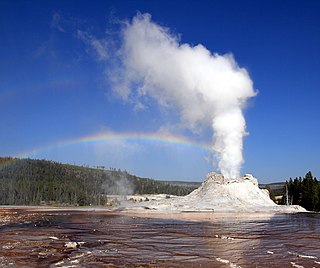
Castle Geyser is a cone geyser in the Upper Geyser Basin of Yellowstone National Park. It is noted for the particularly large geyserite sinter deposits, which form its cone. These deposits have been likened in appearance to a castle.

Botryoidal Spring is a fountain-type geyser in the Lower Geyser Basin of Yellowstone National Park in the United States.
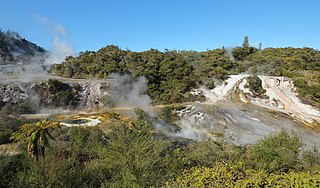
Orakei Korako is a highly active geothermal area most notable for its series of fault-stepped sinter terraces, located in a valley north of Taupō on the banks of the Waikato River in the Taupō Volcanic Zone, New Zealand. It is also known as "The Hidden Valley".
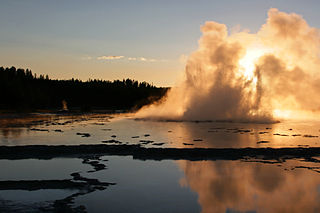
The Great Fountain Geyser is a fountain-type geyser located in the Firehole Lake area of Lower Geyser Basin of Yellowstone National Park, Wyoming. It is the only Lower Geyser Basin feature that the park makes predictions for.

The Pilbara Craton is an old and stable part of the continental lithosphere located in the Pilbara region of Western Australia.

Champagne Pool is a prominent geothermal feature within the Waiotapu geothermal area in the North Island of New Zealand. The terrestrial hot spring is located about 30 km (20 mi) southeast of Rotorua and about 50 km (30 mi) northeast of Taupō. The name Champagne Pool is derived from the abundant efflux of carbon dioxide (CO2), similar to a glass of bubbling champagne. The hot spring was formed 900 years ago by a hydrothermal eruption, which makes it in geological terms a relatively young system. Its crater is about 65 m (213 ft) in diameter with a maximum depth around 62 m (203 ft) and is filled with an estimated volume of 50,000 m3 (1,800,000 cu ft) of geothermal fluid.
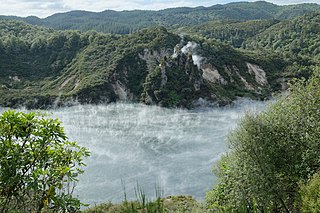
The Waimangu Volcanic Rift Valley is the hydrothermal system created on 10 June 1886 by the volcanic eruption of Mount Tarawera, on the North Island of New Zealand. It encompasses Lake Rotomahana, the site of the Pink and White Terraces, as well as the location of the Waimangu Geyser, which was active from 1900 to 1904. The area has been increasingly accessible as a tourist attraction and contains Frying Pan Lake, which is the largest hot spring in the world, and the steaming and usually pale blue Inferno Crater Lake, the largest geyser-like feature in the world although the geyser itself cannot be seen since it plays at the bottom of the lake.

Grotto Geyser is a fountain-type geyser located in the Upper Geyser Basin in Yellowstone National Park in the United States. Grotto Geyser is the namesake for the group of geysers that includes Grotto Fountain Geyser, South Grotto Fountain Geyser, Indicator Spring, Spa Geyser, Startling Geyser, and Rocket Geyser.

Doublet Pool is a hot spring in the Upper Geyser Basin of Yellowstone National Park, Wyoming.

White Dome Geyser is a geyser located in the Lower Geyser Basin in Yellowstone National Park in the United States.

The earliest known life forms on Earth may be as old as 4.1 billion years old according to biologically fractionated graphite inside a single zircon grain in the Jack Hills range of Australia. The earliest evidence of life found in a stratigraphic unit, not just a single mineral grain, is the 3.7 Ga metasedimentary rocks containing graphite from the Isua Supracrustal Belt in Greenland. The earliest direct known life on land may be stromatolites which have been found in 3.480-billion-year-old geyserite uncovered in the Dresser Formation of the Pilbara Craton of Western Australia. Various microfossils of microorganisms have been found in 3.4 Ga rocks, including 3.465-billion-year-old Apex chert rocks from the same Australian craton region, and in 3.42 Ga hydrothermal vent precipitates from Barberton, South Africa. Much later in the geologic record, likely starting in 1.73 Ga, preserved molecular compounds of biologic origin are indicative of aerobic life. Therefore, the earliest time for the origin of life on Earth is at least 3.5 billion years ago, possibly as early as 4.1 billion years ago — not long after the oceans formed 4.5 billion years ago and after the formation of the Earth 4.54 billion years ago.
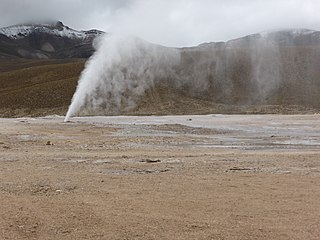
Puchuldiza is a geothermal field in the Tarapacá Region of Chile. It is part of the Central Volcanic Zone of the Andes, close to the active volcano Isluga and several older volcanoes in the neighbourhood; the most recent activity from one of the neighbouring volcanoes was 900,000 ± 300,000 years ago. Geothermal features include geysers and hot springs. Puchuldiza has been inspected for the possibility that it may be suitable as a source for geothermal energy.

Hveravellir is a geothermal field of the Oddnýjarhnjúkur-Langjökull subglacial volcanic system in the north of Langjökull glacier.

Geothermal activity is a group of natural heat transfer processes, occurring on Earth's surface, caused by the presence of excess heat in the subsurface of the affected area. Geothermal activity can manifest itself in a variety of different phenomena, including, among others, elevated surface temperatures, various forms of hydrothermal activity, and the presence of fumaroles that emit hot volcanic gases.
